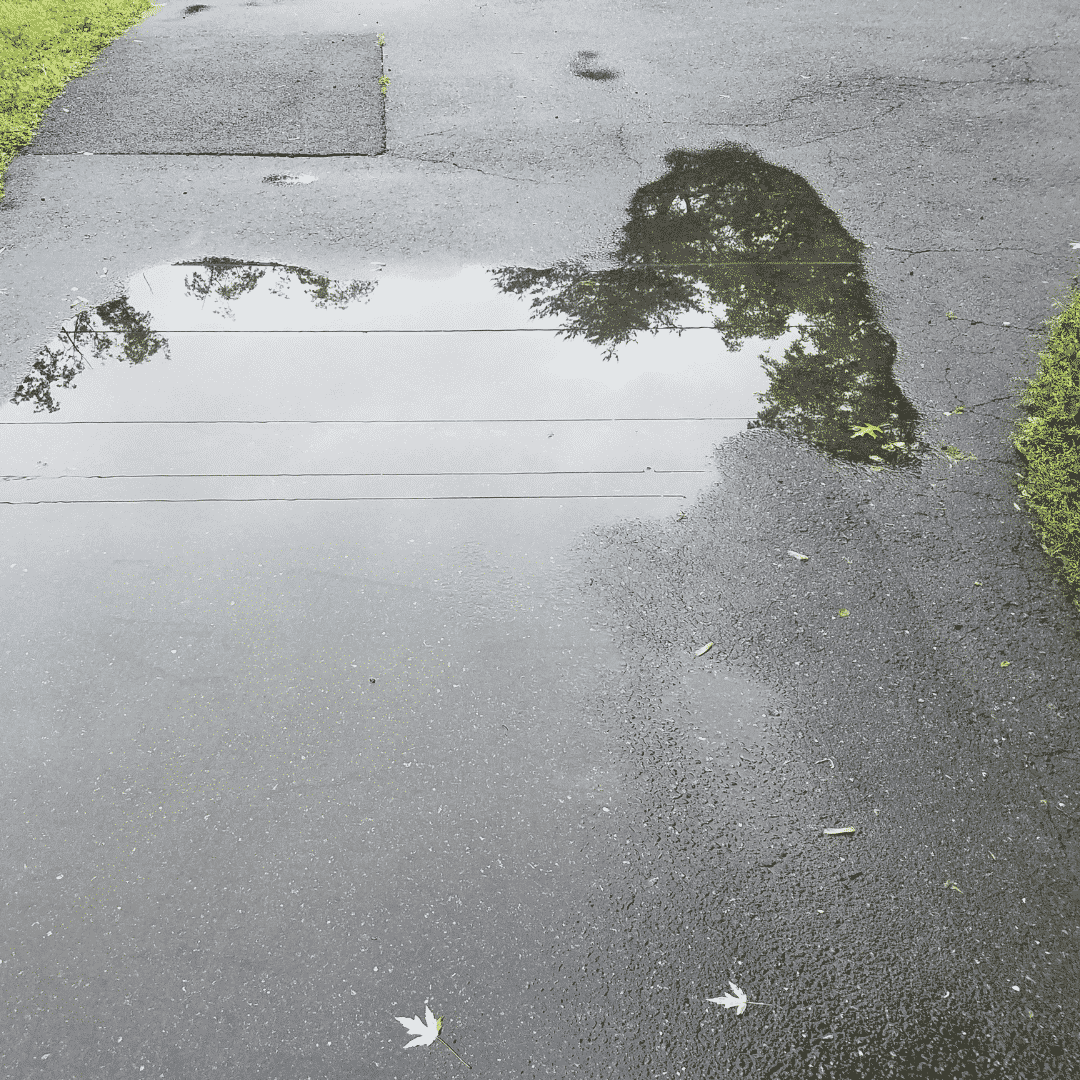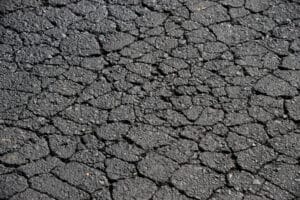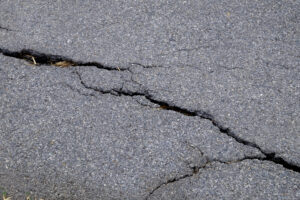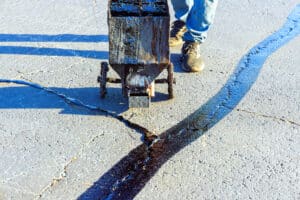Standing water on asphalt is not only a nuisance but it can be costly for businesses and homeowners alike. It’s important to understand the causes of standing water and what you can do to prevent it from happening in your parking lot or driveway. In this article, we will discuss how standing water on asphalt happens and what you need to know about parking lot drainage systems.
Standing Water on Asphalt
As a business owner or property manager, you may not be aware of how much it costs to replace an asphalt parking lot due to standing water on the surface. There are several factors that contribute to this happening, including weather conditions and poor drainage systems.
A proper installation is important when you’re building new or repairing existing pavement but sometimes even with good drainage in place, there can still be issues caused by standing water. In some cases, it may be necessary to install additional drainage features or even a completely new system in order to alleviate the problem.
What Does Standing Water Look Like?
Standing water can look like a number of things, depending on the condition of your parking lot or driveway. In some cases, it may be just a few inches deep and in others, it could be several feet high.
The water can also cause damage to the surface of the asphalt, leading to asphalt cracking and potholes. If left untreated, the standing water can also cause rust and corrosion to metal surfaces, as well as mold and mildew growth.
What Causes Standing Water?
There are several factors that can contribute to standing water on asphalt, including the following:
- Weather conditions (rainfall, snowmelt, etc.)
- A poor parking lot drainage system
- Improperly sloped pavement
- Debris or foreign objects blocking parking lot drains and drainage grates
- Puddles form after a rainstorm
Issues Standing Water Causes
In addition to the damage that standing water can cause to the surface of asphalt, it can also lead to several other problems, including:
- Structural damage to the pavement: When water sits on the surface of asphalt for an extended period, it can cause the pavement to weaken and eventually break. This can lead to big parking lot repairs bills or even a complete replacement of the asphalt parking lot.
- Vehicle damage: The standing water can also cause significant damage to vehicles that drive or park on the lot. In some cases, standing water can even be the culprit behind tire blowouts.
- Pedestrian safety: If there’s a large puddle or pool of standing water, it could pose a danger to pedestrians walking on the parking lot as well. At worst, someone could slip and fall if they’re not careful about where they step.
Overall, it’s important to identify the source of any standing water on your parking lot or driveway. This requires diligence and patience, but it will pay off in the end by preventing damage that can be quite costly.
How to Prevent Standing Water on Asphalt
There are several things that you can do to prevent standing water on asphalt, including the following:
- Install a good drainage system — This is one of the most crucial measures you can take to prevent standing water. Ensuring that your drainage system is properly designed and installed by a professional is key to effectively managing standing water, as standing water can lead to various issues if not addressed.
- Keep the parking lot clean and free of debris — This will help to ensure that water can flow freely through the drainage system. If there is a lot of debris and other obstacles in the way, it can cause blockages that result in standing water. Maintaining a clear path in the drainage system is essential to avoid the accumulation of standing water, so regularly clearing out debris can help prevent standing water on your asphalt.
- Ensure proper slope — Sloping your parking lots properly is also important for avoiding standing water, because this will help with surface runoff after it rains or snows. If you have an area where rainfall pools up, it’s likely due to poor slope.
- Parking lot striping — This can also help to channel water in certain areas of the parking lot where it tends to pool up. Striping your asphalt will make it easy for drivers (and pedestrians) to see where they’re supposed to be driving or walking so that they don’t slip and fall when standing water is present.
- Sealcoating — Sealcoating is a great preventative measure to take so that you don’t have to deal with standing water or other issues caused by moisture penetration.
- Patching and repairing potholes — If you already have some asphalt cracking and potholes, it’s important to patch and repair them as soon as possible. Potholes can cause water to pool and stagnate, leading to even more damage.
- Crack Sealing — Sealing cracks in your asphalt will help to prevent water from seeping through and causing further damage.
These are just a few tips on how to prevent standing water on asphalt.
Additionally, you should also consider installing a parking lot or driveway sealer to provide additional protection from moisture penetrating the surface of your asphalt. A quality sealer will add an extra layer of protection and help to keep your pavement looking new for years to come.
Moreover, sometimes low spots form if the base underneath the asphalt fails. For repairing the issue, a skin patch can be a cost-effective way to minimize the standing water, though this often doesn’t eliminate it completely. The best thing to do is to saw cut and remove the asphalt, inspect, and repair the road base underneath, and re-pave.
If you’re experiencing standing water on asphalt, it’s important to act right away to avoid further damage.
Parking Lot Drainage
Installing a drainage system is one of the most important things that you can do to prevent standing water on your parking lot or driveway. A good drainage system will help to move water away from the surface of the asphalt and keep it from sitting and causing damage.
Moreover, asphalt needs drainage because though it is permeable pavement, it doesn’t absorb every ounce of water. So. if there’s a large puddle or pool of standing water on your parking lot because of rainfall, poor drainage system design and installation can cause significant damage to vehicles that drive or park on the lot. As a result, ensuring that your parking lot has adequate drainage is critical.
A standing water-free parking lot:
- Potholes and puddles are kept to a minimum, allowing staff and customers to park with ease.
- Allows consumers and employees to avoid slips and falls by reducing the risk of accidents.
- Keep your parking lot clean and safe by eliminating unsanitary standing water.
- The parking lot looks better for longer, making a good first impression on customers or visitors entering your business premises.
- Prevents bugs and mosquitoes from breeding, which can lead to the spread of diseases.
A properly functioning drainage system is an essential part of any parking lot or driveway.
Parking Lot Drainage Solutions
If you are experiencing parking lot drainage issues, don’t fret. There are many different parking lot drainage solutions available, but here’s an overview of a few of them:
Catch Basins — Catch basins are a common type of drainage system that is often used in parking lots. They are installed in the ground and have a grate on the top that allows water to flow into them. The catch basin then channels the water away from the surface of the asphalt.
Grates — Grate covers should be placed over all storm drains in your parking lot to keep trash and other debris from getting into the drainage system.
Curbs — Curb drains are also a common type of parking lot drain that is installed along the edges of asphalt driveways or parking lots. However, it’s important not to confuse curbs with gutters, which would be located on either side of your driveway or parking lot.
Drainage Pipes — If your parking lot is large, you may need to install drainage pipes to move the water away from the surface. This can be done by either installing a mainline that runs the length of the lot, or by installing individual lines at each end.
Shoulder Drainage — If your parking lot or driveway is adjacent to a street, you may want to consider installing a shoulder drainage solution. This type of system will help to move water away from the edge of the asphalt and from flowing onto the street.
Drain Trenches — Drain trenches are a way to move water away from the surface of your asphalt parking lot. They come in different sizes and depths. Therefore they can be installed at specific locations throughout the parking lot or driveway as needed.
Drainage Inlets — Drain Inlets help direct water to catch basins or drainage pipes. These lead it away from your asphalt parking lot or driveway.
Retaining Walls — Retaining walls help keep standing water away from the asphalt by trapping it behind the wall. This is a helpful solution if you have a slope on your property that leads to your parking lot or driveway.
There are many different types of parking lot drainage systems available. Therefore, it’s important to choose the one that will work best for your specific situation. It’s also important to make sure that your drainage system is installed by a professional in order to ensure proper
Asphalt Drainage, Puddle, and Maintenance Tips for Your Property
Here are a few tips for drainage and maintenance:
- Inspect your drainage system regularly to make sure it’s functioning properly.
- Make sure that all catch basins, grates, and drains are clear of debris.
- Repair any cracks or holes in your asphalt as soon as they appear.
- If you have a large pool of water, try to move it to another part of the parking lot
- If you have a drainage system, try to direct the water into it using boards or wood.
- After heavy rainfall events, inspect your parking lot. Look for areas that are either raised up higher than others or lower down relative to the surrounding area. You can fill these in with more asphalt or gravel if needed.
The best way to manage standing water on asphalt parking lots or driveways is through regular maintenance and inspection. Additionally:
- Keeping debris away from your drainage system
- Inspecting the surface regularly for potential problems
- Maintaining any repairs that are made to your lot’s drainage system
Will also help you keep it functioning properly so that puddles don’t accumulate in the first place.
When your asphalt drainage problems need professional help, Superior Asphalt, LC is your Utah asphalt repair partner.
We provide asphalt repair, maintenance, and preservation services to residential and commercial properties alike. We have the knowledge and experience to solve all your asphalt drainage needs, big or small. Get in touch with us today to request a quote!




